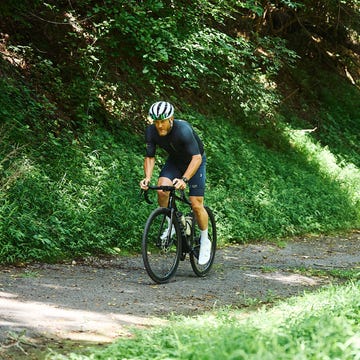Modern cross-country bikes are increasingly more versatile and enjoyable to ride outside the hyper-specific racing setting. The history of the Cannondale Scalpel largely mirrors this industry-wide progression to race bikes with slacker geometry and more suspension travel.
While the latest Scalpel doesn’t look all that different from the bike it’s replacing, it offers many welcome changes. There are no longer two frame versions that are differentiated by the amount of suspension travel they have. The Scalpel is now a 120mm front and rear travel bike across the board. Cannondale also ditches its proprietary Ai wheel spacing, which made sense in theory, but in practice, it meant that non-Cannondale wheels needed to be redished to work. The weird 83 mm wide PF30 bottom bracket is also gone, replaced by a standard BSA threaded bottom bracket.
The rear axle now features a UDH that allows SRAM’s latest Transmission derailleurs to be used. The seatpost is a very standard 31.6 mm diameter, allowing for a wide selection of dropper posts. There’s even a tidy chain guide integrated into the frame for extra insurance on rough courses.
There’s a lot to love about the new Scalpel. Cannondale has gone out of its way to fix many of the proprietarily annoying things that bugged me about the previous Scalpel. However, plenty of minor quirks and one big change would make me think twice before purchasing a new Scalpel.
Through the headset routing on mountain bikes is here
Fully hidden cable routing is now the norm on high- and mid-tier drop-bar bikes. This trend is increasingly extending to mountain bikes, with the Scott Spark, Canyon Lux, Specialized Epic 8, and now the Scalpel joining this growing list of bikes with the pointless and annoying feature of through-the-headset cable routing.
If you can’t tell, I don’t think through the headset cable routing on mountain bikes is a good idea. My main gripe is that it’s a feature with no actual benefit for riders. It’s even tough to make an aesthetic argument for it since any control lines still need to run externally to the headset from the handlebar anyway, so it’s not like you even get the benefit of a super clean cockpit. At best, it hides a few extra inches of hose that now enters through the stem and that’s about it.
There is certainly no aerodynamic argument to be made at mountain bike speeds, and even if there were, a number plate would go there anyway, rendering any potential aero savings from hiding the cables moot.
Stepping away from looks and performance, headset bearings' serviceability and life span take a hit. Not to mention, additional friction is added to the system if you run a cable-actuated dropper post.
Finally, Cannondale’s assembly manual states, "Every 6 months, the headtube system should be inspected by a professional bicycle mechanic. Inspection should include all internally routed cables, wires, the sleeve, headset parts, the frame interior, headtube and downtube, and the fork steerer. Any factors contributing to cable rubbing wear must be corrected and any worn parts replaced with new ones.”
I do want to cut Cannondale some slack here. As I mentioned in the opening of this section, they are not alone in doing this with their cross-country race bikes. Looking inside the Scalpel headtube shows that a lot of care went into designing a system that is fundamentally safe and only as annoying as it has to be. My fundamental gripe is that all of it is done to get cables through the headset, which, at best, has questionable benefits for the rider.
Geometry Updates
Many cross-country race bikes from large brands have coalesced around similar geometry numbers and the Scalpel sits somewhere in the middle between the most progressive and most old-school bikes in the category. Effective seat and head tube angles on all sizes of the Scalpel are 75.5º and 66.6º respectively. For context, Specialized’s Epic 8 is roughly a degree slacker at the head tube, while the Canyon Lux is about two degrees steeper.
Riders have only four frame sizes to choose from, which isn’t uncommon in the category. However, some brands, like Canyon and Trek, still offer five sizes.
Pricing and Models
At the top of the range is the ludicrously priced Lab71 model, which is the only complete bike available with Cannondlaes' signature Lefty fork. It’s also the only model that comes stock with a lockout, a convenience that will cost you $14,000.
If the price of the top-tier model frightens you, the good news is that the other four models in the Scalpel range are priced much more reasonably by comparison. Scalpel 1 gets Fox Factory level suspension, XO AXS Transmission, and DT Swiss wheels for $9,500 (currently on sale for $7,600).
I tested the Scalpel 2 model, which uses GX AXS Transmission, Cannondale’s HollowGram carbon wheels, and RockShox SID Select+ suspension. It retails for $6,500 but is on sale for $5,250.
At the bottom of the range are the mechanically shifting Scalpel 3 and 4. While the MSRPs on these models are $5,500 and $4,000, the Scalpel 3 is currently on sale for $4,500. For the $500 price bump, the 3 gets Shimano XT shifting and SID Select Suspension, while the 4 rolls on Deore and base-level SID suspension.
Currently, the Scalpel is not available as a frameset in the US.
Ride Impressions
The new Scalpel is perfectly on trend with other modern cross-country race bikes. That is to say, for most riders who are not focused on the gravity side of mountain biking, the Scalpel is probably the right bike. With 120mm of front and rear travel and modern geometry numbers, the Scalpel is perfectly capable of handling a wide variety of terrain.
If you swap out the stock XC race tires for something with a bit more bite, the Scalpel can easily double as a lightweight trail bike. Cannondale did an excellent job with its unique flex pivot design, which mimics a horst link suspension layout. This results in a suspension that feels much more linear throughout its travel while minimizing harsh bottom-outs on bigger hits.
Uphill performance is outstanding. Traction on technical climbs was excellent and even in places where I missed having a remote lockout, there was a good amount of anti-squat that kept the Scalpel high in its travel and feeling fast. I don’t think most riders will miss the remote lockout. While it’s nice to have in particular situations, it’s certainly not worth spending the extra $8,750 over the Scalpel 2 to get it.
Cannondale also did a great job building in a lot of compliance into the Scalpel without dulling it as a race bike. It’s noticeably more pleasant to ride in rocky and bumpy terrain than the Canyon Lux Trail or the YT Izzo. The ability to carry two full-sized bottles on every frame size makes the Scalpel an excellent choice for longer trail days.
I have some minor gripes with some of the parts choices Cannondale made on the Scalpel 2, particularly the two-position dropper post. Sure, it’s lightweight, but always needing to push it all the way down to get it to drop is, at best, annoying and, at worst, a recipe for having an unintentionally raised saddle at the worst possible moment because you didn’t do a deep enough squat going into a downhill section. I would also swap out the stock rear tire as soon as possible. The Aspen is undoubtedly a fast tire, but even at very low pressures I found that it broke traction too easily under both pedaling and braking.
Despite the minor gripes about parts and the large gripe about through-the-headset cable routing, Cannondale did a fantastic job with the new Scalpel. They ditched all the proprietary parts and standards while adding features riders expect from a modern cross-country bike. Then delivered it in a range of bikes that (if you ignore the ridiculous top model) delivered great value relative to models from other brands.
$6,500 at mikesbikes.com $5,249 at Cannondale
Test Editor Dan Chabanov got his start in cycling as a New York City bike messenger but quickly found his way into road and cyclocross racing, competing in professional cyclocross races from 2009 to 2019 and winning a Master’s National Championship title in 2018. Prior to joining Bicycling in 2021, Dan worked as part of the race organization for the Red Hook Crit, as a coach with EnduranceWERX, as well as a freelance writer and photographer.




















